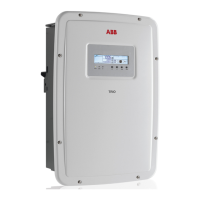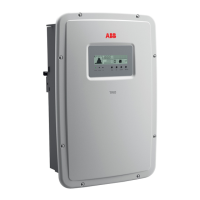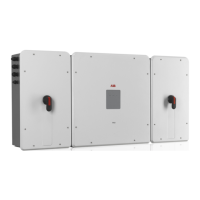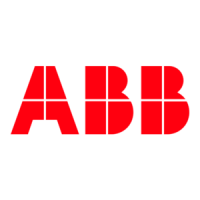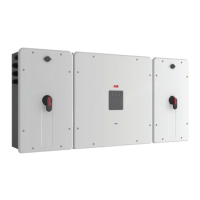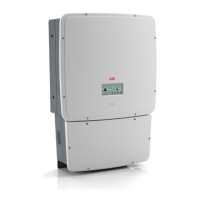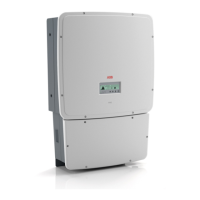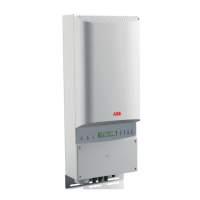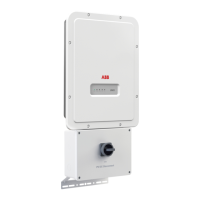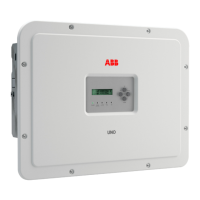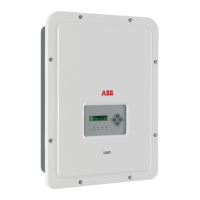Do you have a question about the ABB TRIO-5.8-TL-OUTD and is the answer not in the manual?
Details warranty terms and conditions for equipment usage and compliance.
Explains the manual's purpose, structure, and intended audience.
Defines hazard symbols, labels, and icons used in the manual and on equipment.
Outlines intended use, limits, and prohibited actions for the equipment.
Introduces technical terminology and information structure within the manual.
Describes different inverter models based on output power and features.
Explains labels and information on the equipment for identification.
Details internal components and their reference numbers for various inverter models.
Describes optional accessories like Wifi Logger and expansion boards.
Provides detailed technical specifications, input/output data, and performance metrics.
Specifies torque values for securing components and maintaining IP protection.
Shows dimensions for the wall mounting bracket in mm and inches.
Graphs illustrating inverter efficiency at different output power levels and DC voltages.
Explains automatic reduction of power output due to operating conditions.
Defines strings and arrays within a PV generator system.
Explains the inverter's function and basic operating diagram.
Details how to connect multiple inverters for increased system capacity.
Provides considerations for structuring a photovoltaic system.
Describes features like configurable relay, remote control, and power management modes.
Summarizes the internal structure and main blocks of the inverter.
Covers general safety, manufacturer liability, and training requirements.
Discusses environmental risks, flammability, and operator hazards.
Warns about hot components and fire safety precautions.
Specifies required PPE and safety practices for personnel.
Lists remaining risks and suggested remedies despite safety systems.
Notes that some recommendations apply to larger products or multiple packings.
Provides guidelines for safe transport and handling to prevent damage.
Details procedures and requirements for safely lifting the equipment.
Instructs on careful unpacking and inspection for damage or missing parts.
Enumerate all components provided with the inverter for installation.
Lists the weight of the inverter and its lifting points.
Emphasizes that performance depends on correct installation and connections.
Lists checks for environmental parameters and installation site suitability.
Discusses altitude effects on cooling, dielectric resistance, and component failure.
Provides guidelines for selecting an optimal and safe installation location.
Details the procedure for securely mounting the inverter on a wall.
Explains the step-by-step process for opening the inverter's front cover.
Covers checks for polarity, leakage, and differential protection.
Explains how to configure input channels for independent or parallel operation.
Provides examples of PV generator configurations for MPPT setup.
Details DC input connections for standard inverter models without disconnect switch.
Describes DC input connections for -S models using quick fit connectors.
Guides on installing Weidmüller and Multicontact connectors.
Covers AC connection to the grid, earthing, and load protection requirements.
Details AC line conductor sizing and maximum length.
Identifies connectors and functions on the communication board.
Explains how to connect and control the inverter remotely.
Details connecting devices to the configurable alarm relay.
Covers RS485 PC communication setup and cable connections.
Explains RS485 connection procedures for monitoring systems.
Emphasizes the importance of understanding instruments for safe operation.
Describes display fields, symbols, and their meanings.
Explains the function of keys and LED indicators for inverter status.
Highlights automatic operation and checks for environmental conditions.
Explains how the inverter provides operational information.
Guides through the initial setup and configuration steps after installation.
Outlines parameters adjustable via the display menu.
Provides instructions for updating inverter firmware using an SD card.
Explains how operating data and graphs are shown on the display.
Details inverter operating states indicated by LED combinations.
Relates LED status to display messages and operational states.
Explains navigation and information displayed in various menu screens.
Describes how to access and view production statistics (total, partial, daily, etc.).
Covers access to configuration settings like address, display, language, and protection.
Details the procedure for running automatic tests for grid compliance.
Provides a step-by-step guide for safely turning off the inverter.
Stresses that maintenance must be done by specialized staff after disconnecting power.
Recommends periodic checks for optimal performance and component integrity.
Guides on understanding and resolving warning and error messages.
Lists common alarms, their causes, and suggested solutions.
Explains messages indicating output power limitations due to settings or conditions.
Details the procedure for safely removing the inverter from its installation.
Guides on obtaining a service menu password via online registration.
Explains how to reset the 24-hour window for changing grid standards.
Provides instructions for replacing the CR2032 buffer battery.
Describes how to check for ground faults in the PV generator.
Details the procedure for measuring PV generator insulation resistance.
Covers proper storage, decommissioning, and disposal of equipment components.
Directs users to the ABB website for additional product and service details.
Provides contact information and website for customer support.
| Model | TRIO-5.8-TL-OUTD |
|---|---|
| Type | String Inverter |
| Max Output Power | 5800 W |
| Input Voltage Range | 200 - 800 V |
| MPPT Voltage Range | 200 - 800 V |
| Number of MPPT | 2 |
| Operating Temperature Range | -25°C to +60°C |
| Cooling | Natural convection |
| Protection Class | IP65 |
| Frequency | 50/60 Hz |
| Max. AC Power | 5800 W |
| Nominal AC Voltage | 230 V |
